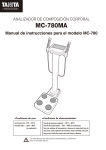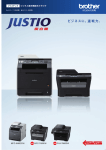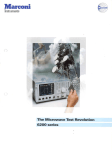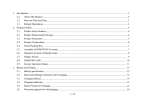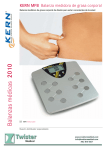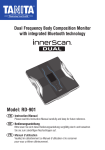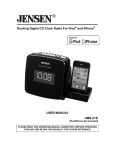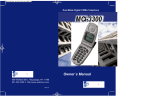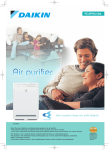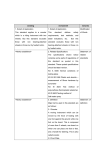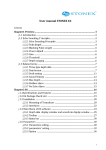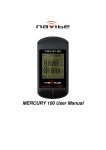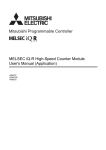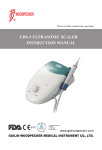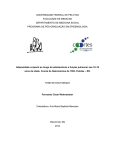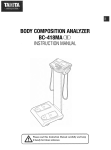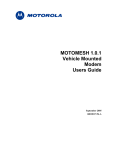Download How to Use - Fysiopartner AS
Transcript
BODY COMPOSITION ANALYZER MC-780MA Instruction Manual Separate Version <Usage Conditions> Temperature : 5°C to35°C Relative Humidity : 30% to80% (without condensation) Maximum Altitude : 2,000m ASL Pressure : 86kPa to106kPa Column Mounted Version <Storage Conditions> Temperature : -10°C to50°C RelativeHumidity : 10% to90% (without condensation) To avoid malfunctions, avoid storing the equipment in a place with direct sunlight, significant temperature changes, a risk of dampness, a large amount of dust or a risk of vibration or impact, or in the vicinity of flames. Please read this Instruction Manual carefully and keep it for future reference. Intended Use GB Tanita Body Composition Analyzers have been clinically proven to be accurate, reliable and provide highly repeatable results. Our Analyzers are used worldwide by health, research and medical professionals primarily in the following fields: - medical screening and health assessments of adults and children - monitoring the progress of weight loss during medical treatment relating to lifestyle diseases such as diabetes, hyperlipidemia, bariatric surgery, hypertension and fatty liver disease. - monitoring increases of muscle mass, reduction of body fat and hydration levels as part of a fitness or training program - assessing the true effectiveness of nutrition and physical activity programs where body mass index cannot identify key changes in body composition - collating subject data for large cohort research studies Efficacy This product has been specifically designed to be simple to use and required no additional user assistance to take a measurement. Measurements can be taken in under 30 seconds for maximum convenience. 2 Contents GB Before Use For Your Safety 4 Part Names & Connection Procedure 8 Power Supply 10 Settings 11 How to Use Taking a Measurement 13 Body Composition Mode 13 Measurement Results 15 Scale Mode 17 Weight Lock Mode 18 Various Criteria 19 Output and Storage of Measurement Results 24 If Necessary Troubleshooting 26 Body Water and Extracellular Water 27 Technical Notes 28 The Regression Formula for Basal Metabolic Rate(BMR) 32 Specifications 34 3 For Your Safety GB Before Use This section explains precautionary measures to be taken to avoid injury to the users of this device and others, and to prevent damage to property. Please familiarise yourself with this information to ensure safe operation of this equipment. Warning Caution Failure to follow instructions highlighted with this mark could result in death or severe injury. Failure to follow instructions highlighted with this mark could result in injury or damage to property. This mark indicates actions that are prohibited. This mark indicates instructions that must always be followed. Warning This equipment must not be used on subjects with pacemakers or other mechanical implants. This equipment passes a weak electrical current through the body which could interfere with and cause the malfunction of electrical medical implants, resulting in serious harm. Do not handle the plug with wet hands. This may result in electric shock, fire, or leakage. Prohibited Keep this equipment away from flammable gas and oxygen-rich environments. Do not modify this equipment in any way. This can cause electric shock or injury, or affect the accuracy of analysis. Do not use a multi-plug adapter. This may cause fire. 4 Keep away from water. Avoid using on subjects with metal allergies. Allergic reactions may be caused by the stainless steel used in the electrodes of this device. Before Use Caution GB Do not jump on the equipment. Do not lean on the equipment. Do not use this equipment near other products that emit electromagnetic waves. Do not insert fingers into gaps or holes. Prohibited Do not apply force to the display. The screen panel may break and cause injury. Do not place items sensitive to magnetic forces near the equipment. The magnet of the impedance meter may cause corruption of data on devices such as USB memory sticks if these are placed near the equipment. Assist persons with disabilities. Another person should assist persons with disabilities who may not be able to take a measurement alone. Clean the scale platform with appropriate disinfectant after each use. Stand clear of the subject during measurement to ensure accuracy. Continually monitor both the subject and the equipment for anomalies. If an anomaly in the subject or equipment is discovered,take appropriate action, such as stopping the equipment, while ensuring the safety of the subject. Use the included AC adapter.(TR30M120) Do not lean against the equipment. Unplug the AC cable from the equipment when moving it. Always… Tighten the adjustable feet when moving the equipment. Interpretation of analysis results (e.g. evaluation of measurements and formulation of exercise programmes based on results) must be performed by a professional. Weight loss measures and exercise based on self-analysis could be harmful to you health. Always follow the advice of a qualified professional. This equipment is designated a Class B IT device (mainly for systems intended to be used in internal environments) and is CE (EMC) certified, but it may affect devices that are sensitive to electromagnetic waves. If connecting a computer or peripheral devices to this equipment, please use devices complying with IEC60601-1 (EN60601-1). Power must be supplied from a medical isolation transformer for IEC60950(EN60950) devices. Keep a distance of 1.5m between units during operation. Failure to do so may cause electric shock to subjects or malfunction. 5 GB Before Use For Accurate Measurements Avoid measuring after strenuous exercise. This may cause inaccurate measurements. Please take measurements after sufficient rest. Avoid measuring after excessive food or fluid intake or when dehydrated. This may cause inaccurate measurements. For greater accuracy, avoid using directly after waking up. Use at the same time on each occasion, at least three hours after a meal. Ensure arms are not touching sides and inner thighs are not touching each other during measurement. If necessary, place a dry towel between arm and side and/or between thighs. Do not take measurements while using transmitting devices, such as mobile phones, which may affect readings. Use the equipment under the same conditions and in the same position as much as possible for accurate tracking of changes. Readings are affected by the level of hydration and position of the body. Please use at the same time of day each time, under the same conditions and in the same body position. Avoid measuring in multiple locations with greatly differing temperatures. This may cause inaccurate measurements. Allow the equipment to stand for at least 2 hours before using if it is moved to a new location with a temperature difference of 20°C or more. Make sure the soles of feet are free of excess dirt, as this may block the mild electric current. Always hold both arms straight down when taking measurements to prevent measurement errors such as undermeasurement of body fat. Bare feet should be placed correctly on the electrode platform. Place arms straight down during measurement. Use in a stable location. Errors in measurements may occur if the device is used in an unstable location. 6 TANITA recommends that each facility conduct periodic checks of each unit. 1. Check the following at least daily: • The unit is on a stable and level surface ie on a firm flooring, not on a thick carpet • Date and time settings Before Use Scheduled Maintenance GB 2. Visually inspect the following at least weekly: • The display for any damage or contamination • All cables, cords, and connector ends for damage or contamination • All safety-related labeling for legibility • All accessories (sensors, electrodes, etc.) for wear or damage 3. Visually inspect the following at least monthly: •Mounting screws on stand Update settings, replace items, or call for service as necessary according to the results of the visual inspections. Do not use the unit if you see any signs of damage. Equipment that has been damaged must be checked for proper operation by qualified personnel before using again. 7 Part Names & Connection Procedure GB Symbols and their Meanings Before Use 0123 Positive polarity Serial interface Conformity with Medical Device Directive 93/42/EEC Direct current Alternating current Class II Equipment Input, Output Type BF applied part - Grips and platform Date of manufacture WEEE - Waste Electrical and Electronic Equipment Directives Caution Refer to the attached notes. For indoor use only SD card See the instructions *The SD logo is a registered trademark of the SD Association. Grip Control Unit Casters (x 2) Electrode x 8 Level Gauge Adjustable feet x 4 Platform Checking the level black ring * For accurate measurement, place the machine as level as possible. * Rotate the adjustable feet in 4 positions for adjustment so that the bubbles of the level gauge reach the centre. air bubble Status when the level gauge is viewed from above Control unit Connection of Plugs RS-232C USB A USB B SD card slot 8 Platform Connection of Plugs Communication cable AC adapter GB Display and Keys Before Use MC-780 III Max 270kg Min 2kg e=0.1kg T = -10kg PT Setting 7 8 9 Standard Athletic 4 5 6 Male Female 1 2 3 Age 5 - 99 Height 90.0 - 249.9cm 0 CE Enter Meanings of the LED Indicators and Keys Display Body Fat (percentage and mass) *Not measured value but calculated value Turn ON / OFF the power Display Body Muscle (percentage and mass) *Not measured value but calculated value Printout result Display Body Water (percentage and mass) *Not measured value but calculated value Display Visceral Fat Rating Setting Set various functions Reset zero point PT Set preset value (Clothes weight) Select measurement mode Standard Athletic Male Female Age 5 - 99 Height 90.0 - 249.9cm Display Basal Metabolic Rate Indicates whether "Standard mode or Athletic mode" is selected as the body type. Indicates whether "Male or Female" is selected as the gender Enter the age between "5 to 99 years" Enter the height between "90.0 to 249.9 cm" Enter Confirms the entered numerical value. 9 Power Supply GB Before Use Turning the main power ON/OFF Turning the main power ON. Press the key to turn on the power. The initial screen is displayed. Turning the main power OFF. Press the power off. key to turn the Emergency Shut Down Keep the area around the plug socket clear during operation of the equipment in case of an emergency. 10 Settings GB Setting Before Use 1 Press the mode. key to change the The setting screen is displayed. Note Setting key cannot be used when the scale is measuring weight or impedance. •The 2 Select the setting item from the list below. Enter key. Enter numerical values and Press the Setting item List No. Enter Setting Save changes and return Setting Item Default Page No. Setting Item Default Page 10 Height input unit (0: 0.1cm increments 1: 1cm increments) 0 P.14 11 Automatic determination time of input information (0-9 second(s)) * 0: Disables this function 0 − 18 Target body fat ratio input (0: off 1: on) 0 P.14 19 Printout language (1: English, 2: French, 3: German, 4: Italian, 5: Spanish) 0 − 20 Adjudt printing position (2:↓ , 4:← , 6:→ , 8:↑) − − 21 Timeout function of result display (0: disable 1: enable) 0 − 30 Data output format to PC (0: default format 1: BC-418 format) 0 P.24 31 Display direction (0: default 1: reversal position) 0 − 32 BMI desirable range (0: 18.5 to 25 1: 18.5 to 23) 0 − 60 Reading stored measurement result − P.25 0 Check the software version − − 1 Date and time − P.11 2 Number to be printed automatically (Body composition mode) (0-2 sheet(s)) 0 P.24 3 Number to be printed automatically (Scale mode and Weight lock mode) (0-2 sheet(s)) 0 P.24 4 Select printing paper (0: Pre printed paper 1: Plain paper) 0 − 5 Beep sound (0: off 1: on) 1 − 6 ID number (Manual input) (0: off 1: on) 0 P.13 7 ID number (Automatic count up) (0: off 1: on) 0 P.13 8 Measurement flow (0: Two step flow (Measure body weight first) 1: One step flow (Enter personal information first) 0 P.13 Body type selection (Athletic mode) (0: off 1: on) 2 9 Return without saving P.13 Note Enter the year, month, day, hour and minute. The date format is "yyyy mm dd hh:mm" Example 6:47 pm, 24th September, 2012 "2012" "09 24" "18:47" To enter a number with 1 digit (0 to 9), press "0" first. 11 Settings (continued) GB Before Use Select the Measurement Mode Select the measurement mode by pressing the key. The measurement mode is switched in the following order when the key is pressed: Body Composition Mode MC-780 III Max 300kg Min 2kg e=0.1kg T = -10kg 7 Standard PT Male Age Setting Height "Body Composition" 8 9 Athletic 4 5 6 Female 1 2 3 5 - 99 0 90.0 - 249.9cm CE Enter Scale Mode "Scale" "Scale (Weight Lock Mode)" MC-780 III Max 300kg Min 2kg e=0.1kg T = -10kg Standard PT Male Age Setting Height Athletic Female 5 - 99 7 8 9 4 5 6 1 2 0 90.0 - 249.9cm 3 CE Enter Scale Mode (Weight Lock Mode) The " " mark is displayed when the scale mode is selected. MC-780 III Max 300kg Min 2kg e=0.1kg T = -10kg PT Setting 8 9 Standard Athletic 4 5 6 Male Female 1 2 3 Age Height 12 7 5 - 99 90.0 - 249.9cm 0 CE Enter Taking a Measurement Body Composition Mode ( 2 ) GB How to Use 1 Two step flow Measure body weight first Enter the preset tare value (clothes weight) Turn the power on, and check that the " " mark is displayed. Enter the preset tare value (clothes weight) The tare value range is 0.0to20.0lb (0.0 to 10.0kg) Measure body weight Step onto the platform with bare feet, after “ ” flashes. " " is displayed when you have entered a tare value (clothes weight). Note When the One step flow is selected, enter personal information first. P.11 Setting 8 If the scale does not detect a load, press to switch to "Input tare value". If the scale detects the load, press to display the entered tare value. 3 Enter ID number If the ID number function is set to OFF, the scale switches directly to "Select body type" without requesting an ID number. The ID number range :0 to 9999999999999999 4 Select body type If the body type selection (Athletic mode) is set to OFF, the scale switches directly to "Select gender" without requesting a body type. The " " mark is displayed when the Athletic mode is selected. Note Athletic mode setting P.11 Setting 9 Athlete condition P.25 13 Taking a Measurement (continued) GB Body Composition Mode How to Use 5 6 Select gender Enter age Female Male Age Standard PT Age Setting Height The age range : 5 to 99 7 Enter height Standard PT Setting Female 5 - 99 9 5 6 1 2 0 90.0 - 249.9cm 3 CE Enter Male Age Height 7 8 9 Athletic 4 5 6 Female 1 2 5 - 99 90.0 - 249.9cm 0 3 CE Enter Set target body fat ratio If the target body fat ratio function is set to OFF, the scale switches directly to "Measuring impedance" without entering the target value. The body fat ratio range:4 to 55 % Note 9 Athletic 8 4 Height The height range : 90.0 to 249.9 cm 8 Male 7 Target Body Fat P.19 Measuring body composition The scale starts measuring impedance after you have entered all of the personal information. The segmental impedance values are measured in order. The scale displays the measurement results after measuring the whole body impedance and segmental impedance. 14 <Child> <Adult> Measurement Results (Body Composition Mode) How to Use Output Measurement Results (Body Composition Mode) GB The measurement results are displayed on the LCD after measurement is completed. The results are output to the PC immediately after measurement is completed. Press the key to select the measurement display. The measurement display is switched in the following order by pressing the key. "Fat" "Muscle" "Body Water" "Visceral fat rating" "Basal metabolic rate" "BMI" Body Fat Fat icon Segmental fat % Body weight (kg) Body fat % Body fat mass (kg) Evaluation of your results compared to average values. Muscle Muscle icon Segmental Muscle Mass Body weight (kg) Body muscle % Body muscle mass (kg) Evaluation of your results compared to average values. 15 Taking a Measurement (continued) GB Measurement Results (Body Composition Mode) How to Use Body water Body weight (kg) Body water % Body water (kg) Body water icon Visceral fat rating Body weight (kg) Visceral fat rating VFR icon Basal metabolic rate Body weight (kg) BMR (kJ) BMR (kcal) BMR icon Body Mass Index (BMI) Body weight (kg) BMI BMI icon 16 Scale Mode 1 Enter the ID number If the ID number function is set to OFF, the scale starts measuring weight immediately. How to Use The " " icon is displayed when the scale mode is selected. GB Enter the ID number. The ID number range is from 0 to 9999999999999999. PT Press to enter tare value (clothes weight). The tare value range is 0.0 to 10.0kg. 2 Measure body weight Step onto the scale, after " " flashes . " " is displayed when you have entered a tare value (clothes weight). The "Stabilised" icon ( ) appears when the load is stable. The "Stabilised" icon ( ) disappears when the load is unstable. When the load is stable, the measurement results are output via the USB port and stored on an SD card. 17 Taking a Measurement (continued) GB Weight Lock Mode How to Use The " " icon and " " are displayed when the weight lock mode is selected. Enter the preset tare value (clothes weight) The " " is displayed after the scale mode is selected. Enter the preset tare value (clothes weight) The tare value range is 0.0 to 10.0kg. Enter the ID number If the ID number function is set to OFF, the scale starts measuring weight immediately. Enter the ID number. The ID number range is from 0 to 9999999999999999. Measure body weight *" 18 " is displayed when you have entered a tare value (clothes weight). Various Criteria - What is body fat percentage? (Applicable age 5 to 99) How to Use Body fat percentage is the amount of body fat as a proportion of your body weight. Reducing excess levels of body fat has shown to reduce the risk of certain conditions such as high blood pressure, heart disease,diabetes and cancer. The chart below shows the healthy ranges for body fat. GB Healthy Range Indicator Your Body Composition Analyzer automatically compares your body fat percentage reading to the Healthy Body Fat Range chart. After your body fat percentage has been calculated, the LCD on the side of the display will light up, identifying where you fall within the Body Fat Ranges for your age and gender. (+) : Overfat and Obese Overfat; above the healthy range. Increased risk for health problems. Obese; high above the healthy body fat range. Greatly increased risk of obesity-related health problems. (0) : Healthy; within the healthy body fat percentage range for your age/gender. ( - ) : Underfat; below the healthy body fat range. Increased risk for health problems. *Note : Athletes may have a lower body fat range depending on their particular sport or activity. 19 Various Criteria (continued) GB - What is total body water percentage? (Applicable age 18 to 99) How to Use Total Body Water Percentage is the total amount of fluid in a person’s body expressed as a percentage of their total weight. Water plays a vital role in many of the body’s processes and is found in every cell, tissue and organ. Maintaining a healthy total body water percentage will ensure the body functions efficiently and will reduce the risk of developing associated health problems. Your body water levels naturally fluctuate throughout the day and night. Your body tends to be dehydrated after a longnight and there are differences in fluid distribution between day and night. Eating large meals, drinking alcohol, menstruation, illness, exercising, and bathing may cause variations in your hydration levels. Your body water percentage reading should act as a guide and should not be used to specifically determine your absolute recommended total body water percentage. It is important to look for long-term changes in total body water percentage and maintain a consistent, healthy total body water percentage. Drinking a large quantity of water in one sitting will not instantly change your water level. In fact, it will increase your body fat reading due to the additional weight gain. Please monitor all readings over time to track the relative change. Every individual varies but as a guide the average total body water percentage ranges for a healthy adult are: Female : 45 to 60% Male : 50 to 65% Source : Based on Tanita's Internal Research Note: The total body water percentage will tend to decrease as the percentage of body fat increases. A person with a high percentage of body fat may fall below the average body water percentage. As you lose body fat the total body water percentage should gradually move towards the typical range given above. - What is visceral fat rating? (Applicable age 18 to 99) This feature indicates the rating of visceral fat in your body. Visceral fat is the fat that is in the internal abdominal cavity, surrounding the vital organs in the trunk (abdominal) area. Research shows that even if your weight and body fat remains constant, as you get older the distribution of fat changes and is more likely to shift to the trunk area especially post menopause. Ensuring you, have healthy levels of visceral fat my reduce the risk of certain diseases such as heart disease, high blood pressure, and the onset of type 2 diabetes. The Tanita Body Composition Analyzer will provide you with a visceral fat rating from 1 to 59. Rating from 1 to 12 Indicates you have a healthy level of visceral fat. Continue monitoring your rating to ensure that it stays within the healthy range. Rating from 13 to 59 Indicates you have an excess level of visceral fat. Consider making changes in your lifestyle possibly through diet changes or increasing exercise. Source : 1) Tanita Institute Contract Study. Algorithm Development for Estimating Visceral Fat Rating. SB Heymsfield MD. Columbia University College of Physicians and Surgeons 2004. 2) Wang, Z., et al. Japanese-American Differences in Visceral Adiposity and a Simplified Estimation Method for Visceral Adipose Tissue. North American Association for the Study of Obesity. Annual Meeting. Abstract 518-P. 2004 Note: •Even if you have a low body fat rate, you may have a high visceral fat level. •For medical diagnosis, consult a physician. 20 - What is basal metabolic rate (BMR)? (Applicable age 18 to 99) About 70% of calories consumed every day are used for your basal metabolism. In addition, energy is used when doing any kind of activity however; the more vigorous the activity is the more calories are burned. This is because skeletal muscle (which accounts for approximately 40% of your body weight) acts as your metabolic engine and uses a large amount of energy. Your basal metabolism is greatly affected by the quantity of muscles you have, therefor increasing your muscle mass will help increase your basal metabolism. How to Use WHAT IS BMR? Your Basal Metabolic Rate(BMR) is the minimum level of energy your body needs when at rest to function effectively including your respiratory and circulatory organs, neural system, liver, kidneys, and other organs. You burn calories when sleeping. GB By studying healthy individuals, scientists have found that as people age, their metabolic rate changes. Basal metabolism rises as a child matures. After a peak at the age of 16 or 17, it typically starts to decrease gradually. Having a higher basal metabolism will increase the number of calories used and help to decrease the amount of body fat. A low basal metabolic rate will make it harder to lose body fat and overall weight. HOW DOES A TANITA BODY COMPOSITION ANALYZER CALCULATE BMR? The basic way of calculating Basal Metabolic Rate BMR is a standard equation using weight and age. Tanita has conducted in-depth research into the relationship of BMR and body composition giving a much more accurate and personalized reading for the user based on the impedance measurement. This method has been medically validated using indirect calorimetry (measuring the breath composition).* * Reliability on equation for Basal Metabolic Rate: At 2002 Nutrition Week : A Scientific and Clinical Forum and Exposition Title: International Comparison: Resting Energy Expenditure Prediction Models: The American Journal of Clinical Nutrition 21 Various Criteria GB - What is muscle mass? (Applicable age 18 to 99) How to Use This feature indicates the weight of muscle in your body. The muscle mass displayed includes the skeletal muscles, smooth muscles (such as cardiac and digestive muscles) and the water contained in these muscles. Muscles play an important role as they act as an engine in consuming energy. As your muscle mass increase, your energy consumption increases helping you reduce excess body fat levels and lose weight in a healthy way. What is physique rating? This feature assesses your physique according to the ratio of body fat ad muscle mass in your body. As you become more active and reduce the amount of body fat, your physique rating will also change accordingly. Even though your weight may not change, your muscle mass and body fat levels may be changing making you healthier and at lower risk of certain diseases. Each person should set their own goal of which physique they would like and follow a diet and fitness program to meet that goal. kg 22 - What is bone mass? (Applicable age 18 to 99) How to Use This feature indicates the amount of bone (bone mineral level, calcium or other minerals) in the body. Research has shown that exercise and the development of muscle tissue are related to stronger, healthier bones. While bone structure is unlikely to make noticeable changes in a short period, it is important that you develop and maintain healthy bones by having a balanced diet and plenty of exercise. People worried about bone disease should consult their physician. People who suffer from osteoporosis or low bone densities due to advanced age, young age, pregnancy,hormonal treatment or other causes, may not get accurate estimations of their bone mass. GB Below is the result of estimated bone masses of persons aged 20 to 40, who are said to have the largest amounts of bone masses, by weight. (Source : Tanita Body Weight Science Institute) Please use the below charts as a guide to compare your bone mass reading. Women : Average of estimated bone mass Weight (kg) Less than 50 kg 50 kg to 75 kg 75 kg and up 1,95 kg 2,40 kg 2,95 kg Men : Average of estimated bone mass Weight (kg) Less than 65 kg 65 kg to 95 kg 95 kg and up 2,66 kg 3,29 kg 3,69 kg Note: Persons described below may obtain varying readings and should take the values given for reference purposes only. - Elderly persons - Women during or after menopause - People receiving hormone therapy "Estimated bone mass" is a value estimated statistically based on its correlation with the fat-free amount (tissues other than the fat). "Estimated bone mass" does not give a direct judgment on the hardness or strength of the bones or the risks of bone fractures. If you have concerns over your bones, you are recommended to consult a specialist physician. 23 Output and Storage of Measurement Results GB Data Output How to Use Outputting measurement results via the USB or RS The results are output to the PC immediately after measurement is completed. Data is output in CSV format. •USB connector (B - Type 4 - pin female) are located on the back of the control box. •Please provide your own cable as necessary as none are included. USB cable : A - Type 4 - pin (male) - B - Type 4 - pin (male) •You must install the necessary driver onto your PC, available download from http://www.tanita.eu Data Storage Data storage of measurement results The results are saved to the SD card immediately after measurement is completed. The icon is displayed when a valid SD card is installed. A new file is created on the SD card for each day. The file is created using the measurement date and time as the file name, as shown below. "YYYYMMDD" (year, month and date) If "error 12" is shown in the display, this indicates that there is not enough free space left on the SD card. You can store approximately 10,000 measurement results (weight only mode) on a 2GB SD card. •Do not remove the SD card when it is storing or reading data. •Do not turn off the main power when the SD card is storing or reading data. Printing Data Printing Measurement Results The results are printed from the printer immediately after measurement is completed. The number of sheets that are printed is set in . Press the key to print additional copies. You can print out the result if is lighted. 24 GB Reading stored measurement result data Select the file that you want to load using the Displaying stored data or key and or key and press . Enter MMDD YYYY Date and time when the displayed data was measured How to Use Reading stored measurement result data (→P.11 Setting 60) Dara ID HH Year, Month and Date Hour, Minute and Second MI SS Switch the display by pressing the key. → Print Body weight (kg) Enter → Next data Body fat % CE → Exit Preset tare (kg) General Instructions for Body Composition Measurement Athletic Mode •Recommended for those who are 18 years or older and meet the following conditions. - People who carry out 12 hours or more of cardiovascular exercise a week. - People who belong to a sport team or a sport organization with the aim of participation in competition, etc. - People who are professional athletes. Target Body Fat •A target body fat % should be set by a professional only. Tanita is not responsible for setting the appropriate target body fat % for specific individuals. Attention •Posture when measuring - Stand with both feet parallel on the electrodes. - Stand without bending knees. •The age input range is 5 to 99 years old. Input age 99 for those who are 100 years or older. Note •Inaccurate results may be reported after excessive food/fluid intake, or after periods of intense exercise. •If clothes weight is input, clothes weight is subtracted from the weight measurements. 25 Troubleshooting GB Please check the following before requesting repair. If Necessary Problem Measurement Display 26 Solution Error with impedance measurement •Hold the handgrips and electrodes firmly with fingers and palms. •Stand barefoot on the platform for measurement. •If the soles of the feet are dry, use the included dropper to apply about 0.5 ml of water before measurement. •Check the input details. Error with zeroing •Turn off the power and remove anything on the platform, then turn on the power and try measuring again. The weight value does not stabilize. •Is the equipment placed on a vibrating surface? •Is the measuring platform tilted? •Is something blocking the gap in the measuring platform? •Remove any inserted objects. Nothing is displayed, even when the power is turned on. •Confirm that the power is connected correctly. “------” is displayed. •The measured weight exceeds weighing capacity. Body Water and Extracellular Water Body water can be broadly classified into extracellular water and intracellular water. The percentage of this water accounted for by extracellular water is known as the extracellular water ratio. If Necessary In medical textbooks, this is defined as: Extracellular Water (ECW): Intracellular Water (ICW) = 1:2 (i.e. an extracellular water ratio of 33%.) Swelling and dehydration are often diagnosed when this ratio is compromised. GB But is this really correct? Can swelling or dehydration occur simply by deviating from this ratio? Drinking water does indeed change the body’s fluid distribution, but caution is required when determining this figure. Just as variation exists in different people’s body composition, variation also exists in different people’s volume of body water and extracellular water ratio. The appropriate data can be obtained by measuring a person’s body composition. Just one measurement however, is not enough to draw a conclusion. This figure needs to be looked at over a period of time. Your health can be better managed by examining this figure along with other indicators such as weight and body fat. 27 Technical Notes GB Body composition measurement by the BIA method. Introduction If Necessary This equipment provides estimated values for each measured value of body fat percentage, fat mass, fatfree mass, muscle mass and bone mass by the DXA method, estimated value for the total body water measured value by the dilution method and estimated value for the visceral fat rating by MRI method using the Bioelectrical Impedance Analysis (BIA method). For measurement, a mode must be selected based on body type. 1) Standard (for 5 to 99 years of age) 2) Athletic (for Athletic persons who exercise considerably more than non-athlete) Making a distinction by body type in the measurement mode produces more reliable body composition measurements for athletic persons, whose body compositions differ from those of average persons. - Principles of body composition measurement BIA is a means of measuring body composition – fat mass, predicted muscle mass, etc. – by measuring bioelectrical impedance in the body. Fat within the body allows almost no electricity to pass through, while electricity passes rather easily through water, much of which is found in muscles. The degree of difficulty with which electricity passes through a substance is known as the electrical resistance, and the percentage of fat and other body constituents can be inferred from measurements of this resistance. The Tanita Body Composition Analyzer measures body composition using a constant current source with a high frequency current (50kHz, 90µA). The 8 electrodes are positioned so that electric current is supplied from the electrodes on the tips of the toes of both feet, and voltage is measured on the heel of both feet. The current flows into the upper limbs or lower limbs, depending on the body part(s) to be measured. - What is the DXA method? DXA was originally designed to measure bone mineral content, but in the full-body scan mode the body fat percentage, fat mass, and fat free mass of individual body parts (arms, legs, trunk) can also be measured. The image below shows one example of body composition measurement results obtained by DXA. Body composition measurement results obtained by DXA (Lunar Co., Ltd; DPX-L) - What is dilution method? In the dilution method, a labeled substance for a known amount is given and the concentration in equilibrium diffusing evenly is measured to obtain the total amount of the solvent that dilutes the labeled substance. To measure the total body water (TBW), deuterium oxide (D2O) is generally used as the labeled substance. Deuterium oxide uses the overall total body water as dilution space so the total body water can be obtained. To obtain the extracellular fluid amount, sodium bromide (NaBr) is used as a labeled substance. Bromine (Br) is said to not enter the inside of cells, and uses extracellular fluid as the dilution space. 28 - What is the visceral fat? Tanita has developed the technology for measuring the VAT accumulation risk through bioelectrical impedance analysis (BIA) in comparison with image analysis applied to magnetic resonance imaging (MRI), in addition to the established technology for measuring the percent of body fat. The VAT accumulation risk is calculated by estimating the VAT area by the BIA method on the basis of MRI image processing. This method has a higher correlation than the estimation of the VAT accumulation risk based on BMI or abdominal circumference (waist circumference), allowing estimation that corresponds more precisely to individuals. * The VAT area by MRI is calculated by carrying out an image processing of the cross section of the lumber vertebra L4-L5 regions. If Necessary Visceral Adipose Tissue (VAT) has been associated with increased risk of developing lifestyle-related diseases. Accordingly, knowing and periodically checking the estimated VAT accumulation serves as one factor of a number of factors in assessing the prevention of lifestyle related diseases. GB (Fig. 1 - Fig. 3: Research results by N. Y. Columbia University and Jikei University Published by the North American Association for the Study of Obesity [NAASO] in 2004.) 29 Technical Notes (continued) GB - Factors giving errors in measurement If Necessary In the BIA method, impedance is measured and the body composition is calculated based on the value. It is known that impedance changes by the amount of the total body water that occupies about 60% of weight and the change in its distribution and temperature change. Therefore, for the purpose of research or for daily repeating of measurements, the measurement conditions must be kept constant. Measurement under the changing conditions of temperature and total body water distribution or blood flow volume of extremities due to exercising, taking a bath, etc., affects the measurement result since the electric resistance in the body also changes. Therefore, it is recommended to measure under the following conditions for stable measurement. 1) 3 hours have passed after getting up and normal lifestyle activities are carried out during this period. (The impedance transits staying at a high level if you remain sitting after getting up or drive a car, etc.) 2) 3 hours or more have passed after eating. (For 2 to 3 hours after eating, the impedance has a tendency to decrease.) 3) 12 hours or more have passed after vigorous exercise for measurement. (The tendency toward changes in impedance is not stable depending on the type and rigorousness of the exercise.) 4) If possible urinate before taking measurement. 5) For repeated measurements, measure at the same hour as much as possible. (At the same time of measurement of weight, the measurements can be made more stable by measuring at the same time of the day) Very stable measured values can be obtained by measuring under the above conditions. And in the development of this equipment, the following 6 items were set as conditions for the regression equation. 1) Prohibition of alcohol intake for 12 hours before measurement 2) Prohibition of excessive exercise for 12 hours before measurement. 3) Prohibition of excessive eating and drinking the day before measurement 4) Prohibition of eating and drinking for 3 hours before measurement 5) Urination just before measurement 6) Avoid measurements during menstruation (for female) 2) Inter-day changes The diagrams below offer examples of actual measurements made of inter-day changes. A study was done to determine the degree of change in the impedance between the feet during dehydration; the first two days represent a normal daily routine, while in the latter two days a state of dehydration was induced using a sauna. No significant inter-day change was measured in body weight, impedance between the feet, or body fat percentage during the normal daily routine. During the dehydrated state, however, a drop in body weight of 1kg was noted, with the impedance between the feet rising approximately 15Ω on the first day of dehydration and 30 to 35Ω on the second day. As a result, body fat percentage was up by around 1% on the first day of dehydration and by 1.5 to 2% on the second day. As mentioned earlier, impedance increases when body weight is reduced (such as by dehydration), and decreases when body weight is increased through excess consumption of food and drink. The inter-day change in impedance is thus inversely proportional to the change in body weight. 30 GB If Necessary These inter-day changes stem from such causes as: 1) Temporary increases in body weight (total body water) through overeating and overdrinking 2) Dehydration due to heavy sweating during vigorous exercise 3) Dehydration due to alcohol consumption or the use of diuretics 4) Dehydration due to heavy sweating during saunas, etc. Accordingly, it is recommended that instructions be provided to the subject to help eliminate these causes when accurate measurements are needed. 31 The Regression Formula for Basal Metabolic Rate (BMR) GB If Necessary It has long been said among medical and nutritional specialists that "The Basal Metabolic Rate (BMR) is more determined by the Fat Free Mass (FFM) than by the body weight" (Persons of a given body weight with a higher FFM will have a higher BMR), and that from the aspect of evaluating the body composition, should be estimated from the FFM. In addition, in cases of simple estimation formulae which can calculate from the height, weight and age, without evaluating the body composition, there was a problem with excessively high evaluations being given to obese persons with large body weight, and conversely excessively small BMR evaluations given to muscular athletes, though these are not as many in number. Currently, the BMR estimation recursion formula developed by Tanita, the manufacturer of body composition analyzers, based on their research, works by multiple regressive analysis using this FFM, and has a higher degree of accuracy in the individual differences in body composition. In order to derive the BMR, resting respiratory metabolism (Resting Energy Expenditure: REE) was measured using a breath gas analysis device, and this estimation recursion formula was created based on this data. <Figure 1> The Relationship Between Resting Energy Expenditure (REE) According to Breath Gas Analysis and Weight, FFM (Presented at Nutrition Week, Held in San Diego in 2002) As shown in Figure 1: the REE (BMR) has a stronger relationship to the FFM than to body weight, and a difference is visible between males and females in the distribution trends. We see that in principle that we should calculate from the FFM rather than by the old formula centred on the relationship with weight. 32 <Figure 2> Comparison of BMR Values from the TANITA Multiple regression model and Breath Analysis NOTE: This model has been calibrated for those between ages of 18 to 84. Those individuals outside of this age range may not be obtain accurate readings. If Necessary (Presented at Nutrition Week Held in San Diego in 2002) The current BMR retrogression formula is a formula which acts on the principle of using the FFM value from the results of body composition measurement according to the BIA, A good relationship is shown in the BMR value based on actual breath analysis REE or R=0.9 (p<0.0001). These results were presented at the First Annual Nutrition Week (American College of Nutrition, American Society for Clinical Nutrition, American Society for Parenteral and Enteral Nutrition, North American Association for the Study of Obesity) held in 2002 in San Diego. GB 33 Specifications GB Model Number MDD: CLASS IIa NAWI: CLASS III 100 to 240V AC Power Source 18VA Electric Current Range Multi-Frequency 8 Electrode Measurement System 5kHz/50kHz/250kHz Measurement Frequency Up to 90µA Measurement Current Impedance Feet: Stainless steel/Handgrips: plated Electrode Materials Measurement Whole body/Right arm/Left arm/Right leg/Left leg Measurement Part 75.0Ω to 1,500.0Ω (0.1Ωincrements) Measurement Range Accuracy at First Calibration ± 2% Strain Gauge Load Cell Measurement System 270kg (including preset tare value) Maximum Capacity Weight Measurement Minimum Graduation 0.1kg Accuracy at First Calibration ± 0.2kg Dual LCD screen Display USB B-type connector (device) RS-232C Interface USB mini-B (for PictBridge printer) SD card*4 Temperature 5˚C to 35˚C Usage Conditions Relative humidity 30% to 80% (without condensation) Product Weight Pole type: 15.5kg / Separate type 11.1kg Platform size: 360mm x 360mm Height: 94mm Platform Product Size Height(Column Mounted Version) 1165mm Accuracy Grade If Necessary 34 MC-780MA 0 to 10.0kg (0.1kg increments) Up to 16 digits Female/Male Standard/Athletic*1 5 to 99 years 90.0 to 249.9cm (0.1cm increments) 4 to 55%(1% increments ) 16 digits Female/Male Standard/Athletic *1 5 to 99 years 90.0 to 249.9cm (0.1cm increments) 0kg to 10.0kg (0.1kg increments) 0kg to 270.0kg (0.1kg increments) 1.0% to 75.0% (0.1% increments) (0.1kg increments) (0.1kg increments) (0.1kg increments) (0.1 increments) (0.1kg increments) GB If Necessary Clothes Weight Serial No. Gender Input Body Type items Age Height Target Body fat % ID Gender Body Type Age Height Clothes Weight Weight Fat % Fat Mass*3 FFM*3 Muscle Mass*3 BMI Whole Bone Mass*2*3 Body Metabolic Age*2 Output Analysis Basal Metabolic Rate*2 items Visceral Fat Rating*2 TBW*3 TBW % ECW*2 ICW*2 ECW / TBW*2 Muscle Mass*3 Muscle Mass Rating*2 Segmental Fat % Analysis Fat Mass*3 Fat Rating*2 Physique Rating*2 Body Balance Muscle Mass Balance*2 Evaluation Leg Muscle Score*2 Others Bioelectrical data (1kcal/1kJ increments) 1 to 55 (1 increments) (0.1kg increments) (0.1% increments) (0.1kg increments) (0.1kg increments) (0.1% increments) (0.1kg increments) -4 to +4 (1 increments) (0.1% increments) (0.1kg increments) -4 to +4 (1 increments) Reactance/Resistance/Phase Angle *1 Athletic mode can be selected only for ages 18 to 99. *2 18 to 99 years *3 Calculated value *4 Compatible with SD and SDHC memory cards Note Not compatible with SDXC memory cards 35 Disposal This product meets the following requirements ; 1. Non-Automatic Weighing Instruments (2009/23/EC) 2. Medical Device Directive (93/42/EEC) 3. RoHS Directive (2011/65/EU) This equipment is an electronic device. Please therefore dispose of it as an electronic device instead of as general household waste. Please follow regional regulations for disposal. <EU representative> Hoogoorddreef 56-E, 1101 BE Amsterdam, The Netherlands Tel: +31-20-560-2970 Fax: +31-20-560-2988 http://www.tanita.eu 1-14-2, Maeno-cho, Itabashi-ku, Tokyo, Japan Tel: +81 (0) 3-3968-7048 Fax: +81 (0) 3-3967-3766 http://www.tanita.co.jp 2625 South Clearbrook Drive, Arlington Heights, Illinois 60005, U.S.A. Tel : +1-847-640-9241 Fax: +1-847-640-9261 http://www.tanita.com Unit 301-303,Wing On Plaza, 3/F., 62 Mody Rord, Tsimshatsui East, Kowloon, Hong Kong Tel : +852-2834-3917 Fax: +852-2838-8667 www.tanita.asia A-502, Mittal Commercia, Off. M. V. Road (Andheri Kurla Road), Marol, Andheri-East, Mumbai 400 059 INDIA Tel : +91-22-3192-6107 Fax: +91-22-2859-9143 www.tanita.co.in Room 8005, 877 Huai Hai Zhong Lu, Shanghai, People's Republic of China Tel : +86-21-6474-6803 Fax: +86-21-6474-7901 www.tanita.com.cn (Shanghai) Trading Co., Ltd. © 2015 TANITA Corporation MC7807601(0)-1501FA






































